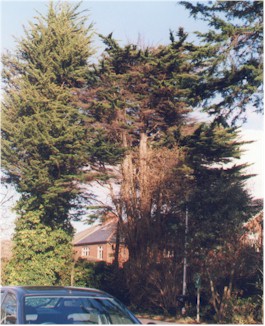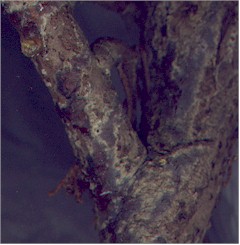 Common Name(s): Coryneum Canker
Common Name(s): Coryneum Canker| Coryneum Canker (Seiridium cardinale) |
 Common Name(s): Coryneum Canker
Common Name(s): Coryneum Canker
Scientific Name(s): Seiridium cardinale
Type: Fungal.
Principle Host Trees & Shr
ubs:Common on Monterey Cypress (Cupressus macrocarpa) and Cupressus sempervirens. Found occasionally on Leyland Cypress (X Cupressocyparis leylandii).
Description, Development & Diagnosis:
This is a bark killing fungus which spreads from tree to tree through the distribution of its spores. The spores infect the tree through natural bark wounds and kills the bark as it spreads. Once an infected branch becomes girdled by the fungus the foliage attached to this branch dies. Dead foliage appears within the crown as brown and golden patches
(see top photograph).Fungal fruiting bodies may develop on areas of infected bark which then release yet more spores to complete the reproductive cycle.
Lower photograph. Tree reacts to the fungal attack by producing resin which becomes encrusted.
 Significance:
Significance:
This is a very common and disfiguring disease of Monterey Cypress which can produce a tree of very poor appearance. Additionally, as branches die and become decayed they can become a serious safety hazard. In advanced stages of the disease, the whole tree can be lost through infection of its main stem or major branches.
Control:
Infected branches can be removed by cutting them below an infected area but such pruning normally only offers a temporary cure.
Also, the removal of such branches and their foliage usually produces an unsightly crown shape which, due to the inability of the Cupressus species to produce new shoots from old wood, is unlikely to be restored.
| Further Information. |
© 2001 Chris Skellern. AIE. Home | News | A-Z Index | Resources | Contact AIE | Terms of Use